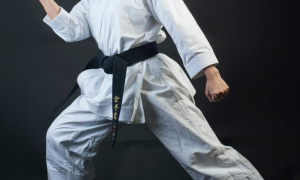
Flexibility, a cornerstone of Taekwondo, is the catalyst that propels your dynamic kicks to new heights. It’s not just a desirable attribute; it’s a necessity for mastering the art of Taekwondo. In this article, we delve into the several must-do Taekwondo stretches, uncovering their indispensable role in perfecting your moves and techniques. We’ll show you how a well-crafted Taekwondo stretching routine can be the key to unlocking your true potential. So, prepare to elevate your practice as we explore the best Taekwondo stretches for flexibility and higher kicks.
Table of Contents
ToggleBest Stretching Exercises for Taekwondo
Dynamic stretching is your gateway to unlocking peak flexibility and higher kicks in your Taekwondo practice. As a prelude to intense activity, dynamic stretches activate your muscles, enhance blood flow, and elevate your heart rate. By mimicking the motions of Taekwondo techniques, these stretches prepare your body for the dynamic kicks and agile movements that define the art.
Here’s a selection of the best stretching exercises for Taekwondo to seamlessly integrate into your warm-up routine:
- Side Neck Rotation Stretch: Gently move your neck from side to side, improving neck mobility crucial for executing spins and quick head movements. This dynamic stretch ensures your neck muscles are limber and ready for action.
- Progressive Air Circle: Rotate your arms in controlled circles, both forward and backward. This stretch enhances shoulder mobility, a key asset for executing powerful kicks and precise strikes.
- Wrist Circles: Mobilize your wrists with this dynamic exercise. Rotate your fists in circular motions to improve wrist flexibility, which is integral for executing blocks, punches, and wrist-related techniques.
- Walking Knee Hug: Elevate your hip flexors and back mobility by alternating between raising your knees and hugging them towards your chest. This stretch primes your lower body for various stances and swift kicks.
- Inchworm: Bridge the gap between flexibility and strength with this stretch. Begin by touching the floor and then “inchworm” your hands forward to a plank position, promoting mobility in back muscles, shoulders, and hamstrings.
- Forward Leg Swing Ups: Swing one leg forward and backward in a pendulum-like motion, targeting leg flexibility and warming up your hamstrings and hip flexors for high kicks.
- Butterfly Stretch with Flapping: Infuse dynamism into the traditional butterfly stretch. Flap your legs like butterfly wings as you gently press them down, combining motion and static stretch benefits.
Best Taekwondo Exercises for Flexibility
The path to Taekwondo mastery is paved with dedication, and regular stretching is a cornerstone of that journey. Incorporating stretching into your daily routine is essential for cultivating the flexibility required to perform high kicks with precision and grace. Here are some key stretches to include in your repertoire:
- Side Splits: Master the art of lateral flexibility with side splits, a stretch that targets your inner thighs and groin muscles.
- Forward Splits: Elevate your high kicks by mastering forward splits, a stretch that contributes to hip and hamstring flexibility. Unleash your potential for higher kicks as you delve into this essential stretch.
- Butterfly Stretch: Unlock your hips’ mobility with the butterfly stretch—a fundamental stretch that improves hip flexibility and facilitates fluid motions in Taekwondo techniques.
- Pike Stretch (Touch Touches): Embrace hamstring flexibility with the pike stretch, also known as touch touches.
- Pigeon Stretch: Enhance your hip and leg flexibility with the pigeon stretch, a staple in many stretching routines and one of the overall best Taekwondo leg stretches.
- Single Leg Crouch: Elevate your lower body flexibility and target your hip muscles with the single leg crouch stretch.
- Knee Rotations and Hip Rotations: Mobilize your joints and improve flexibility simultaneously with knee and hip rotations.
- Side Bend Stretch: Foster spine flexibility and improve your range of motion with the side bend stretch.
Importance of Stretching for higher kicks in Taekwondo
Achieving higher kicks in Taekwondo requires a combination of factors, and flexibility plays a crucial role in this endeavor. Proper stretching techniques can significantly contribute to improving your kicking height. Here’s how taekwondo stretching can help you achieve higher kicks:
- Improved Hip Flexibility: Higher kicks demand greater hip flexibility. Engaging in regular hip-opening stretches like the butterfly stretch, side splits, and pigeon stretch can increase your hip range of motion. This increased flexibility translates to more extended and higher kicks.
- Hamstring Flexibility: Tight hamstrings can limit your kicking height. Incorporating stretches like forward splits and pike stretches can enhance hamstring flexibility. Supple hamstrings allow your legs to extend further, resulting in higher kicks.
- Hip Adductor Flexibility: The muscles on the inner thighs, known as the hip adductors, play a significant role in controlling your leg’s lateral movements. Stretching exercises that target these muscles, such as the side splits, help widen your range of motion and support higher side and roundhouse kicks.
- Regular Dynamic Stretching: Including dynamic stretches in your warm-up routine can help prepare your muscles for explosive movements. Dynamic stretches enhance blood flow, activate muscles, and improve flexibility, setting the stage for higher kicks during your training or sparring sessions.
- Consistency in Stretching: Achieving higher kicks requires consistent effort. Regularly practicing a well-rounded stretching routine, both static and dynamic, can lead to gradual improvements in your flexibility. As your flexibility increases over time, your kicking height will naturally improve.
- Full-Body Flexibility: Remember that flexibility isn’t just isolated to your legs. A well-rounded stretching routine that addresses your entire body, including your back, shoulders, and core, contributes to overall balance and stability during high kicks.
- Cool-Down Stretches: After your Taekwondo practice, cool-down stretches are essential. Incorporating static stretches during your cool-down helps maintain the flexibility you’ve gained, ensuring that your muscles don’t become stiff after an intense workout.
It’s important to note that achieving higher kicks through stretching takes time and dedication. Push yourself within your limits, avoid overstretching, and listen to your body to prevent injuries. By consistently integrating stretching exercises into your Taekwondo training routine, you’ll gradually witness improvements in your kicking height and overall performance.
How important is Flexibility in Taekwondo?
Flexibility isn’t just an abstract concept in Taekwondo; it’s the linchpin that determines your prowess in executing techniques with precision. Picture this: a jump kick that reaches incredible heights, a spinning kick that leaves your opponent awestruck, and high kicks that seamlessly flow from your arsenal. These feats are all the result of flexibility at play.
At the heart of every high kick and explosive movement lies the foundation of flexibility. It’s the secret sauce that amplifies your range of motion and empowers your kicks with unrivaled speed and accuracy. Think of flexibility as the gateway to fluidity in Taekwondo—allowing you to seamlessly transition between moves and positions, making your performance a spectacle to behold.
However, flexibility’s significance extends beyond the surface level of aesthetics. It’s interwoven with strength and balance, forming a trinity of attributes that define a successful Taekwondo practitioner. A well-balanced combination of flexibility, strength, and balance enables you to maintain control over your body in even the most complex and demanding maneuvers.
How to Plan a Taekwondo Stretching Routine?
Before jumping head first into doing any Taekwondo leg stretches it’s crucial to lay a solid foundation. This begins with the warm-up phase—a ritual that primes your body for the forthcoming stretching routine. These warm-ups, which can include light jogging, calisthenics, or aerobic exercises, serve as the perfect prelude to stretching by increasing blood flow, raising core temperature, and loosening up muscles.
For Taekwondo stretches, two distinct approaches take center stage: static and dynamic stretching. Static stretches involve holding a particular position for a duration of time, typically 20 to 45 seconds. This method encourages muscle elongation, enhances flexibility, and improves overall joint range of motion. On the flip side, dynamic stretching involves controlled movements that mimic the motions of Taekwondo techniques. It’s a crucial component of a warm-up routine, as it enhances blood circulation, primes your muscles, and readies your body for the rigorous activity ahead.
An often-overlooked but immensely beneficial facet of stretching is partner stretching. The camaraderie and assistance provided by a partner can significantly enhance your flexibility gains. This technique involves using a partner’s assistance to achieve deeper stretches, which can be particularly effective in eliminating limitations such as balance. Partner stretching not only enhances your flexibility but also fosters teamwork and a sense of community in your Taekwondo journey.
Flexibility Training for Taekwondo Enthusiasts of All Ages
Flexibility knows no age boundaries in Taekwondo. Children possess inherent flexibility, which can be further cultivated with proper training. Meanwhile, adults can enhance their flexibility through consistent practice. Both age groups need to focus on flexibility training, as limber muscles lead to improved performance and reduced injury risk.
For children, flexibility training during growth spurts is crucial. Regular stretches prevent a decline in flexibility during rapid growth phases. Conversely, adults can benefit from structured stretching routines that gradually improve flexibility. Regardless of age, proper warm-up and cool-down stretches are non-negotiable. These practices prevent injuries, enhance technique execution, and promote longevity in your Taekwondo journey.


